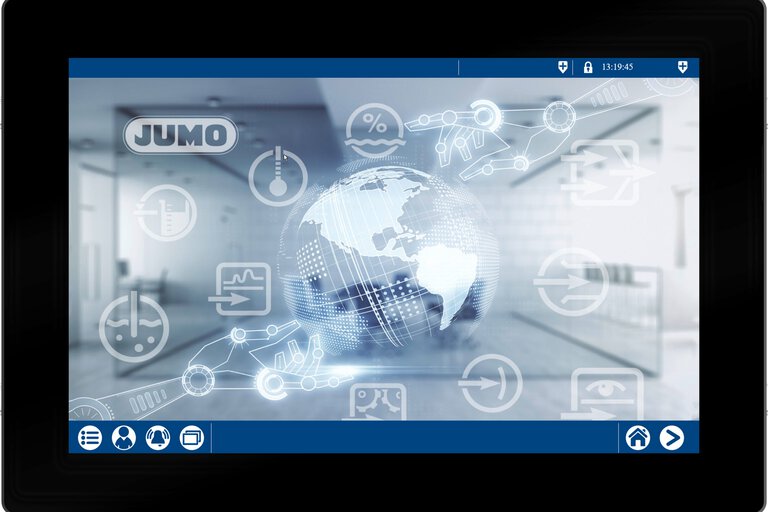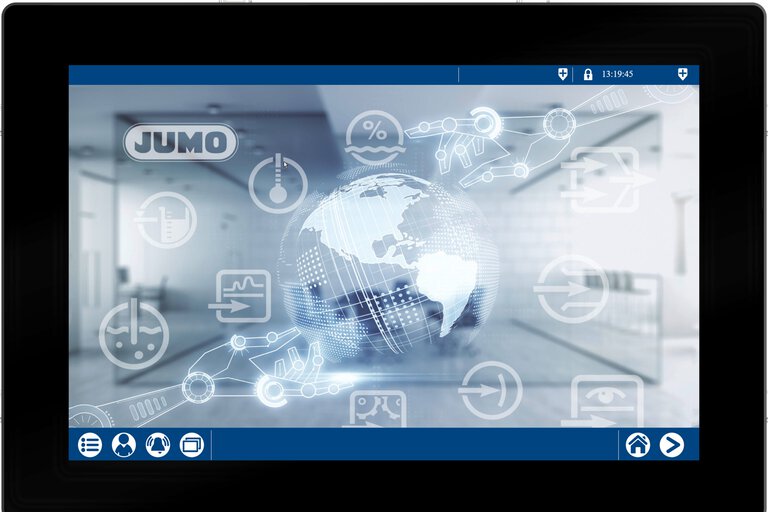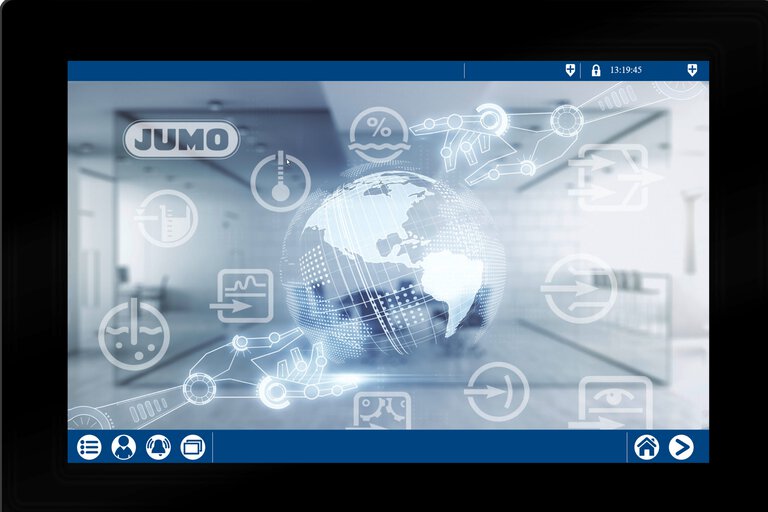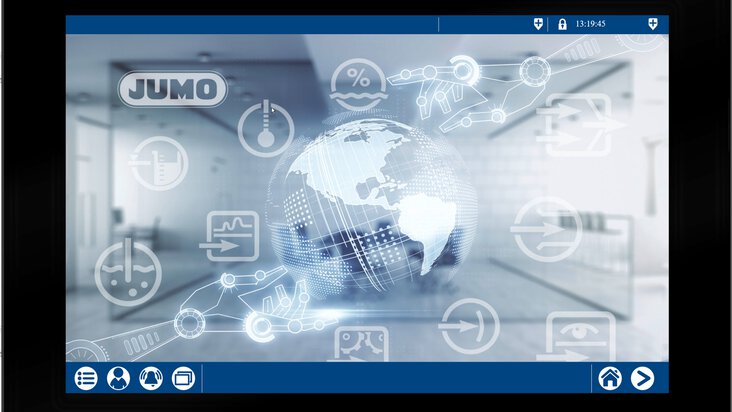
Touch Panels / Panel PLCs – What You Need to Know
As a user-friendly interface between humans and machines, touch panels have become indispensable in modern industrial applications. After all, they enable intuitive operation of machines and plants through touch. They are mostly used as part of a customizable graphical user interface (GUI) that can be used to control, monitor, and configure processes. You can find out more about the functions, areas of application, and advantages of touch panels in the following FAQ text.
Table of contents
What advantages do panel PLCs offer compared to traditional PLC systems?
The combination of touch panel and PLC in a single device offers numerous advantages both in the planning and design of new plants as well as in the modernization of existing systems.
Cost reduction through fewer hardware components
A separate control unit is no longer required, which saves space in the control cabinet and simplifies wiring. Connection cables between HMI and PLC can be eliminated and, if necessary, a smaller control cabinet can even be selected. Storage and spare parts management also benefit from a panel PLC, which leads to a noticeable reduction in overall costs.
Intuitive operation
A key advantage of modern touch panels is their intuitive user interface, which is closely modeled on the user experience of smartphones and tablets. Clear symbols, well-organized menus, and user-friendly navigation enable even minimally trained personnel to operate machines safely and efficiently. Consequently, operating errors are reduced, training times are shortened, and downtimes are minimized. Visual clarity provides a better overview of the plant status – especially in hectic production environments. Not only does this enhance productivity, it also strengthens operational safety.
Quick startup and easy maintenance
The integration of touchscreen operation and programmable logic controller (PLC) in a single device allows the device to be placed into operating mode more quickly. Test and simulation processes can also be carried out more easily, as no separate communication interface needs to be set up. In addition, maintenance is simplified through a central platform for software updates, diagnostics, and error analysis.
Where is a touch panel with PLC function used?
Their high degree of flexibility, modular structure, and easy integration into existing networks make PLC touch panels ideal for use in numerous industries and applications. This is particularly true where operation and control need to be combined in a compact system and a high degree of automation is required.
They are particularly suitable for hygienically sensitive areas, such as the food and pharmaceutical industry, as they offer smooth, easy-to-clean fronts, stainless steel cases, and capacitive glass surfaces without gaps. These prevent the accumulation of pollutants or germs and meet industry-specific standards.
At the same time, they are ideal for continuous industrial use in harsh environments – such as those found in thermal process technology – and impress through their robust housing as well as protection types such as IP65 or IP69K.
What display sizes and performance classes does a touch panel have?
The spectrum ranges from compact 4 or 7 inch touch panels for simple applications to powerful panels with 15 or even 21 inch screen diagonals, multicore CPUs, and high-resolution displays. The appropriate size and computing power can be selected depending on the application and environment – the decisive factors here are the ratio between user-friendliness, visualization requirements, and available space. Classic industrial panels are usually 7 or 10 inches as these sizes offer a good compromise between user-friendliness, clarity, and installation dimensions.
What is the difference between resistive and capacitive touch panels?
Resistive and capacitive touchscreens differ in their operating principle and in their application possibilities. As a result, resistive touchscreens respond to physical pressure which allows them to be operated with gloves, pens, or other objects. They are particularly resistant to dust, moisture, and other environmental influences, which is why they are often used in harsh industrial environments.
Capacitive touchscreens, on the other hand, are based on the electrical conductivity of the human body and respond to touch with the finger. They enable significantly higher precision and support multi-touch gestures similar to those used on smartphones and tablets. That makes them ideal for modern, user-friendly user interfaces such as machines with graphically demanding visualization or applications in which intuitive operation is a priority.
However, the trend is now clearly moving toward capacitive technologies, as these offer greater precision, multi-touch functionality, and modern, user-friendly operation.
Which operating systems use touch panels with PLC function?
The applied operating systems vary depending on the manufacturer and device series. Windows Embedded, Linux-based systems, or special real-time operating systems are frequently used. Linux-based systems benefit particularly from the support of an active open source community, which ensures a high degree of flexibility, customization options, and continuous development. The system must be stable, available over the long term, and optimized for industrial applications.
What visualization software is used in touch panels?
Some manufacturers supply their own engineering tools for configuration and visualization, which are often based on the IEC 61131-3 standard. As an independent provider, the CODESYS Group is the market leader since its software is used for both PLC programming and visualization. Many panel PLCs are therefore CODESYS-compatible or contain an integrated CODESYS runtime kernel (CODESYS PLC). These enable control logic and graphical interface to be implemented in a single development environment, which significantly speeds up project planning and reduces training costs.
The visualization itself is created using the CODESYS Visualization Manager. It makes a variety of objects such as switches, lamps, or bar graphs available that can be placed anywhere on the workspace and linked to the corresponding signals. The display on the panel PLC is implemented using the CODESYS Remote TargetVisu function.
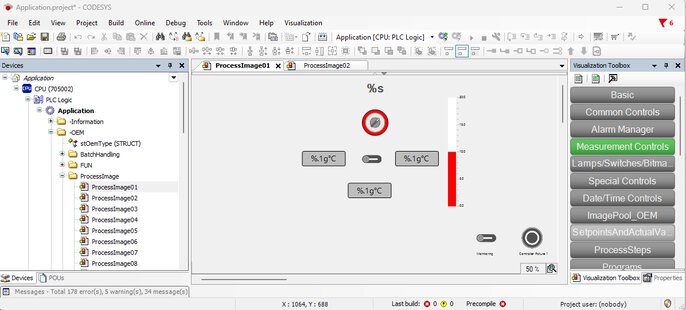
Visualization Manager in CODESYS
How do panel PLCs communicate with process control systems?
PLC touch panels are not only standalone controllers with integrated visualization, but can also be seamlessly integrated into higher-level process control systems (SCADA, cloud). Communication takes place via standardized and widely used industry protocols such as Ethernet/IP, PROFINET, Modbus TCP/IP, OPC UA, or serial interfaces.
These protocols enable bidirectional exchange of control data, process values, alarms, and status information between the panel PLC and the control system. This allows the process control system to:
- Receive real-time data from the PLC to monitor and control the complete process
- Send commands and settings to the panel PLC
- Acquire and evaluate alarms and events centrally
- Save historical data for analysis and reporting
How do panel PLCs contribute to energy conservation and predictive maintenance?
Energy efficiency and predictive maintenance play a central role in panel PLCs. Energy-efficient processors and display technologies make them ideal for 24/7 operation, while low waste heat facilitates installation in compact control cabinet solutions without active cooling. At the same time, panel PLCs enable sensor data to be acquired and evaluated through integrated communication interfaces. In combination with cloud systems, patterns can be identified that indicate upcoming maintenance requirements, thereby preventing downtime and reducing maintenance costs.
How to choose the right touch panel?
The choice of the right panel PLC depends on the application, environment, and control requirements. Factors such as touch technology, display size, interfaces, and expandability should be precisely tailored to the machine. Careful planning is essential, especially for complex process architectures and networked systems, to ensure smooth integration into existing automation networks. Here, it is advisable to consult experienced specialist companies in sensor and automation technology which can develop tailor-made solutions through engineering performance.
- ${title}${badge}
